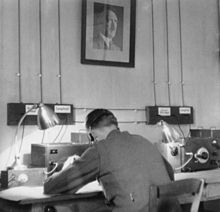 Entering service with both the RAF and 43 squadron in May 1931, the Hawker Fury represented a great leap forward in the quality of fighters available to the RAF. By 1938 newer designs had started to encroach upon the small and nimble Hawker biplanes’ advantage but it still had an important place within the RAF. At the time of the Munich Crisis in 1938, when Europe once again looked set to descend into war, they received a coat of camouflage paint along with many other RAF types. This contrasted sharply with their previous all over silver colours but while war was averted for a short period, the storm clouds had gathered and would not depart.The Munich Agreement was a settlement permitting Nazi Germany's annexation of portions of Czechoslovakia along the country's borders mainly inhabited by German speakers, for which a new territorial designation "Sudetenland"
Entering service with both the RAF and 43 squadron in May 1931, the Hawker Fury represented a great leap forward in the quality of fighters available to the RAF. By 1938 newer designs had started to encroach upon the small and nimble Hawker biplanes’ advantage but it still had an important place within the RAF. At the time of the Munich Crisis in 1938, when Europe once again looked set to descend into war, they received a coat of camouflage paint along with many other RAF types. This contrasted sharply with their previous all over silver colours but while war was averted for a short period, the storm clouds had gathered and would not depart.The Munich Agreement was a settlement permitting Nazi Germany's annexation of portions of Czechoslovakia along the country's borders mainly inhabited by German speakers, for which a new territorial designation "Sudetenland" was coined. The agreement was negotiated at a conference held in Munich, Germany, among the major powers of Europe, excluding the Soviet Union and Czechoslovakia. Today, it is widely regarded as a failed act of appeasement toward Germany. The agreement was signed in the early hours of 30 September 1938 (but dated 29 September). The purpose of the conference was to discuss the future of the Sudetenland in the face of ethnic demands made by Adolf Hitler. The agreement was signed by Germany, France, the United Kingdom, and Italy. Sudetenland was of immense strategic importance to Czechoslovakia, as most of its border defenses were situated there, and many of its banks and heavy industries were located there as well.
was coined. The agreement was negotiated at a conference held in Munich, Germany, among the major powers of Europe, excluding the Soviet Union and Czechoslovakia. Today, it is widely regarded as a failed act of appeasement toward Germany. The agreement was signed in the early hours of 30 September 1938 (but dated 29 September). The purpose of the conference was to discuss the future of the Sudetenland in the face of ethnic demands made by Adolf Hitler. The agreement was signed by Germany, France, the United Kingdom, and Italy. Sudetenland was of immense strategic importance to Czechoslovakia, as most of its border defenses were situated there, and many of its banks and heavy industries were located there as well.
Because the state of Czechoslovakia was not invited to the conference, it considered itself to have been betrayed by the United Kingdom and France, so Czechs and Slovaks call the Munich Agreement the Munich Dictate
The phrase "Munich Betrayal" is also used because the military alliance Czechoslovakia had with France and Britain proved useless. Today the document is typically referred to simply as the Munich Pact (Mnichovská dohoda).
The Sudeten crisis produced serious political instability in Germany, with a secret meeting occurring on 20 September 1938 led by General Hans Oster , deputy head of the Abwehr
, deputy head of the Abwehr and prominent figures within the German military who opposed the regime for its behaviour that was threatening to bring Germany into a war that they believed it was not ready to fight.
and prominent figures within the German military who opposed the regime for its behaviour that was threatening to bring Germany into a war that they believed it was not ready to fight.
 , deputy head of the Abwehr
, deputy head of the Abwehr and prominent figures within the German military who opposed the regime for its behaviour that was threatening to bring Germany into a war that they believed it was not ready to fight.
and prominent figures within the German military who opposed the regime for its behaviour that was threatening to bring Germany into a war that they believed it was not ready to fight.
They discussed overthrowing Hitler and the Nazi regime through a planned storming of the Reich Chancellery by forces loyal to the plot to take control of the government, who would either arrest or assassinate Hitler, and most of the members at the meeting agreed that they would support the restoration of the monarchy of Kaiser Wilhelm II. The plot became known as the Oster Conspiracy.
No comments:
Post a Comment